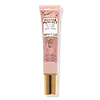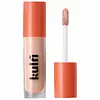Winky Lux Peeper Perfect Under-Eye Concealer Versus Kulfi Main Match Crease-Proof Long-Wear Hydrating Concealer
What's inside
What's inside
 Key Ingredients
Key Ingredients

 Benefits
Benefits

 Concerns
Concerns

 Ingredients Side-by-side
Ingredients Side-by-side

Water
Skin ConditioningParaffinum Liquidum
EmollientPropylene Glycol
HumectantEthylhexyl Palmitate
EmollientHexyl Laurate
EmollientPetrolatum
EmollientGlycerin
HumectantPEG-30 Dipolyhydroxystearate
EmulsifyingDicaprylyl Maleate
EmollientPolyglyceryl-2 Dipolyhydroxystearate
Skin ConditioningCetyl Alcohol
EmollientStearyl Alcohol
EmollientBentonite
AbsorbentCera Alba
EmollientLecithin
EmollientSilica Dimethyl Silylate
EmollientTrimethylolpropane Tricaprylate/Tricaprate
EmollientDimethicone
EmollientMagnesium Sulfate
Tocopherol
AntioxidantPhenoxyethanol
PreservativeOlea Europaea Fruit Oil
MaskingChlorphenesin
AntimicrobialTheobroma Grandiflorum Seed Butter
Skin ConditioningHydrolyzed Collagen
EmollientEthylhexylglycerin
Skin ConditioningVitis Vinifera Seed Extract
AntimicrobialSodium Hyaluronate
HumectantCI 77891
Cosmetic ColorantCI 77491
Cosmetic ColorantCI 77492
Cosmetic ColorantCI 77499
Cosmetic ColorantWater, Paraffinum Liquidum, Propylene Glycol, Ethylhexyl Palmitate, Hexyl Laurate, Petrolatum, Glycerin, PEG-30 Dipolyhydroxystearate, Dicaprylyl Maleate, Polyglyceryl-2 Dipolyhydroxystearate, Cetyl Alcohol, Stearyl Alcohol, Bentonite, Cera Alba, Lecithin, Silica Dimethyl Silylate, Trimethylolpropane Tricaprylate/Tricaprate, Dimethicone, Magnesium Sulfate, Tocopherol, Phenoxyethanol, Olea Europaea Fruit Oil, Chlorphenesin, Theobroma Grandiflorum Seed Butter, Hydrolyzed Collagen, Ethylhexylglycerin, Vitis Vinifera Seed Extract, Sodium Hyaluronate, CI 77891, CI 77491, CI 77492, CI 77499
Water
Skin ConditioningEthylhexyl Palmitate
EmollientHydrogenated Poly(C6-14 Olefin)
EmollientPolyglyceryl-6 Pentaoleate
EmulsifyingCaprylic/Capric Triglyceride
MaskingCapryloyl Glycerin/Sebacic Acid Copolymer
Skin ConditioningGlycerin
HumectantSodium Chloride
MaskingSilica
AbrasiveCalcium Sodium Borosilicate
Ceresin
Emulsion StabilisingTocopherol
AntioxidantCrocus Sativus Flower Extract
MaskingEmblica Officinalis Fruit Extract
Skin ConditioningGlycyrrhiza Glabra Root Extract
BleachingRosa Canina Fruit Extract
AstringentHibiscus Sabdariffa Flower Extract
Skin ConditioningHelianthus Annuus Seed Oil
EmollientSesamum Indicum Seed Oil
EmollientBrassica Campestris Seed Oil
Skin ConditioningTriethoxycaprylylsilane
Propylene Carbonate
SolventStearalkonium Hectorite
Gel FormingPhenoxyethanol
PreservativeEthylhexylglycerin
Skin ConditioningPotassium Sorbate
PreservativeSodium Benzoate
MaskingCI 77891
Cosmetic ColorantIron Oxides
Water, Ethylhexyl Palmitate, Hydrogenated Poly(C6-14 Olefin), Polyglyceryl-6 Pentaoleate, Caprylic/Capric Triglyceride, Capryloyl Glycerin/Sebacic Acid Copolymer, Glycerin, Sodium Chloride, Silica, Calcium Sodium Borosilicate, Ceresin, Tocopherol, Crocus Sativus Flower Extract, Emblica Officinalis Fruit Extract, Glycyrrhiza Glabra Root Extract, Rosa Canina Fruit Extract, Hibiscus Sabdariffa Flower Extract, Helianthus Annuus Seed Oil, Sesamum Indicum Seed Oil, Brassica Campestris Seed Oil, Triethoxycaprylylsilane, Propylene Carbonate, Stearalkonium Hectorite, Phenoxyethanol, Ethylhexylglycerin, Potassium Sorbate, Sodium Benzoate, CI 77891, Iron Oxides
Ingredients Explained
These ingredients are found in both products.
Ingredients higher up in an ingredient list are typically present in a larger amount.
Ci 77891 is a white pigment from Titanium dioxide. It is naturally found in minerals such as rutile and ilmenite.
It's main function is to add a white color to cosmetics. It can also be mixed with other colors to create different shades.
Ci 77891 is commonly found in sunscreens due to its ability to block UV rays.
Learn more about CI 77891Ethylhexyl Palmitate, also known as octyl palmitate, is created from 2-ethylhexyl alcohol and palmitic acid. It is a fatty acid ester.
The fatty acid content of Ethylhexyl Palmitate makes it an emollient. Emollients help soften and hydrate your skin by trapping moisture within.
Ethylhexyl Palmitate is also used to help improve the texture of cosmetics. It helps other ingredient dissolve in products and help disperse ingredients more evenly.
You'll likely find this ingredient in sunscreen, as it is often used to mix UV-blocking ingredients such as avobenzone and ethylhexyl triazone.
It can also help stabilize the fragrances in a product as a fragrance fixative.
Ethylhexyl Palmitate can be used to substitute mineral oil.
Due to its high fatty acid content, it may not be fungal-acne safe.
Learn more about Ethylhexyl PalmitateEthylhexylglycerin (we can't pronounce this either) is commonly used as a preservative and skin softener. It is derived from glyceryl.
You might see Ethylhexylglycerin often paired with other preservatives such as phenoxyethanol. Ethylhexylglycerin has been found to increase the effectiveness of these other preservatives.
Glycerin is already naturally found in your skin. It helps moisturize and protect your skin.
A study from 2016 found glycerin to be more effective as a humectant than AHAs and hyaluronic acid.
As a humectant, it helps the skin stay hydrated by pulling moisture to your skin. The low molecular weight of glycerin allows it to pull moisture into the deeper layers of your skin.
Hydrated skin improves your skin barrier; Your skin barrier helps protect against irritants and bacteria.
Glycerin has also been found to have antimicrobial and antiviral properties. Due to these properties, glycerin is often used in wound and burn treatments.
In cosmetics, glycerin is usually derived from plants such as soybean or palm. However, it can also be sourced from animals, such as tallow or animal fat.
This ingredient is organic, colorless, odorless, and non-toxic.
Glycerin is the name for this ingredient in American English. British English uses Glycerol/Glycerine.
Learn more about GlycerinPhenoxyethanol is a preservative that has germicide, antimicrobial, and aromatic properties. Studies show that phenoxyethanol can prevent microbial growth. By itself, it has a scent that is similar to that of a rose.
It's often used in formulations along with Caprylyl Glycol to preserve the shelf life of products.
Tocopherol (also known as Vitamin E) is a common antioxidant used to help protect the skin from free-radicals and strengthen the skin barrier. It's also fat soluble - this means our skin is great at absorbing it.
Vitamin E also helps keep your natural skin lipids healthy. Your lipid skin barrier naturally consists of lipids, ceramides, and fatty acids. Vitamin E offers extra protection for your skin’s lipid barrier, keeping your skin healthy and nourished.
Another benefit is a bit of UV protection. Vitamin E helps reduce the damage caused by UVB rays. (It should not replace your sunscreen). Combining it with Vitamin C can decrease sunburned cells and hyperpigmentation after UV exposure.
You might have noticed Vitamin E + C often paired together. This is because it is great at stabilizing Vitamin C. Using the two together helps increase the effectiveness of both ingredients.
There are often claims that Vitamin E can reduce/prevent scarring, but these claims haven't been confirmed by scientific research.
Learn more about TocopherolWater. It's the most common cosmetic ingredient of all. You'll usually see it at the top of ingredient lists, meaning that it makes up the largest part of the product.
So why is it so popular? Water most often acts as a solvent - this means that it helps dissolve other ingredients into the formulation.
You'll also recognize water as that liquid we all need to stay alive. If you see this, drink a glass of water. Stay hydrated!
Learn more about Water